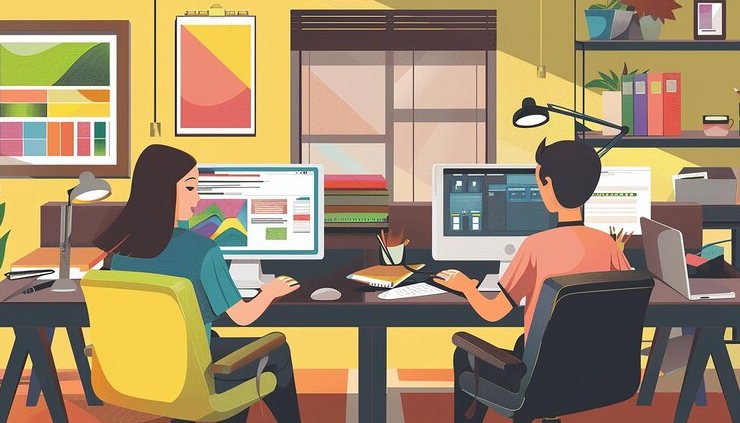Creating compelling backgrounds in 2D animation is crucial for setting the scene, establishing mood, and enhancing the storytelling. Well-designed backgrounds can make the difference between a good animation and a great one. Whether you’re a professional animator or a hobbyist, understanding the best practices for creating backgrounds can elevate the quality of your work. In this blog, we will explore these practices in detail, incorporating insights and techniques that are utilized by some of the best animation companies in the industry.
1. Understanding the Role of Backgrounds
Backgrounds serve multiple functions in 2D animation:
- Setting the Scene: They provide context for the characters and action.
- Establishing Mood: Color schemes, lighting, and design elements contribute to the overall mood of the scene.
- Enhancing Storytelling: Backgrounds can include elements that support the narrative, such as props or environmental clues.
- Providing Depth: Through techniques like parallax scrolling, backgrounds can give a sense of depth and dimension.
2. Research and Reference
Before starting, gather references and conduct research. Look at the work of renowned 2D animation services and study how they approach backgrounds. Analyze various styles, from classic animations to modern productions. References can include photographs, paintings, and other animations.
- Art Books: Many animation art books provide behind-the-scenes looks at the background creation process.
- Online Resources: Websites like ArtStation, DeviantArt, and Pinterest offer a plethora of visual references.
3. Conceptualization and Storyboarding
Start with rough sketches and storyboards. This helps in visualizing the scenes and planning the layout.
- Thumbnails: Create small, quick sketches to explore different compositions.
- Storyboards: Develop detailed storyboards to map out the entire animation. This helps in understanding how backgrounds will interact with characters and actions.
4. Composition Principles
Effective composition is key to creating engaging backgrounds. Utilize composition principles to guide the viewer’s eye and enhance the narrative.
- Rule of Thirds: Divide the frame into a 3×3 grid and place key elements along these lines or intersections.
- Leading Lines: Use lines within the background to direct the viewer’s gaze towards focal points.
- Balance: Ensure elements are balanced within the frame, avoiding clutter or empty spaces.
- Depth: Create a sense of depth using foreground, middle ground, and background elements.
5. Color Theory
Color plays a vital role in conveying mood and emotion. Understanding color theory can help in choosing the right palette for your backgrounds.
- Color Palettes: Select a cohesive color palette that aligns with the overall theme and mood.
- Contrast: Use contrasting colors to highlight important elements and create visual interest.
- Temperature: Warm colors (reds, oranges) evoke warmth and energy, while cool colors (blues, greens) create calmness and distance.
6. Lighting and Shadows
Proper lighting and shadowing add realism and depth to backgrounds.
- Light Sources: Identify the primary light sources in your scene and ensure consistency.
- Shading: Use shading techniques to add dimension and form to background elements.
- Atmospheric Perspective: Distant objects should be lighter and less detailed to simulate atmospheric haze.
7. Texture and Detail
Textures and details enhance the visual richness of backgrounds.
- Texturing: Use textures to add realism. This can be achieved through brushstrokes, patterns, or digital textures.
- Details: Incorporate small details that add authenticity without overwhelming the scene.
8. Parallax Scrolling
Parallax scrolling creates an illusion of depth in 2D animation by moving background layers at different speeds.
- Layering: Divide the background into multiple layers (foreground, middle ground, background).
- Movement: Move each layer at different speeds to create a sense of depth.
9. Consistency and Style
Maintaining a consistent style is crucial for cohesive storytelling.
- Style Guide: Develop a style guide that includes color palettes, textures, and design elements.
- Consistency: Ensure all backgrounds adhere to the established style guide.
10. Software and Tools
Various software and tools can aid in creating high-quality backgrounds.
- Adobe Photoshop: A versatile tool for painting and texturing backgrounds.
- Procreate: An iPad app favored by many professional animators for its intuitive interface and powerful features.
- Toon Boom Harmony: A comprehensive animation software with tools for creating and integrating backgrounds.
Case Studies from Best Animation Companies
Analyzing the work of top animation companies can provide valuable insights into best practices.
- Studio Ghibli: Known for their richly detailed and beautifully painted backgrounds that enhance the storytelling.
- Disney Animation Studios: Renowned for their meticulous attention to detail and innovative use of color and lighting.
- Cartoon Saloon: Celebrated for their unique, hand-drawn style and use of vibrant color palettes.
Conclusion
Creating backgrounds in 2D animation is an art that requires a blend of creativity, technical skill, and attention to detail. By following these best practices, you can create compelling and visually stunning backgrounds that enhance your animations. Whether you’re working with a team of professionals at a top animation studio or independently, these principles will help you achieve high-quality results. Embrace the process, experiment with different techniques, and always strive for improvement. The world of 2D animation is vast and full of possibilities, and with the right approach, you can bring your backgrounds to life in ways that captivate and inspire your audience.
Remember, the key to excellence in background creation lies in continuous learning and adaptation. Keep exploring new styles, studying the work of the best animation companies, and refining your skills. With dedication and passion, you can master the art of creating backgrounds that not only complement your animations but also elevate them to new heights.
